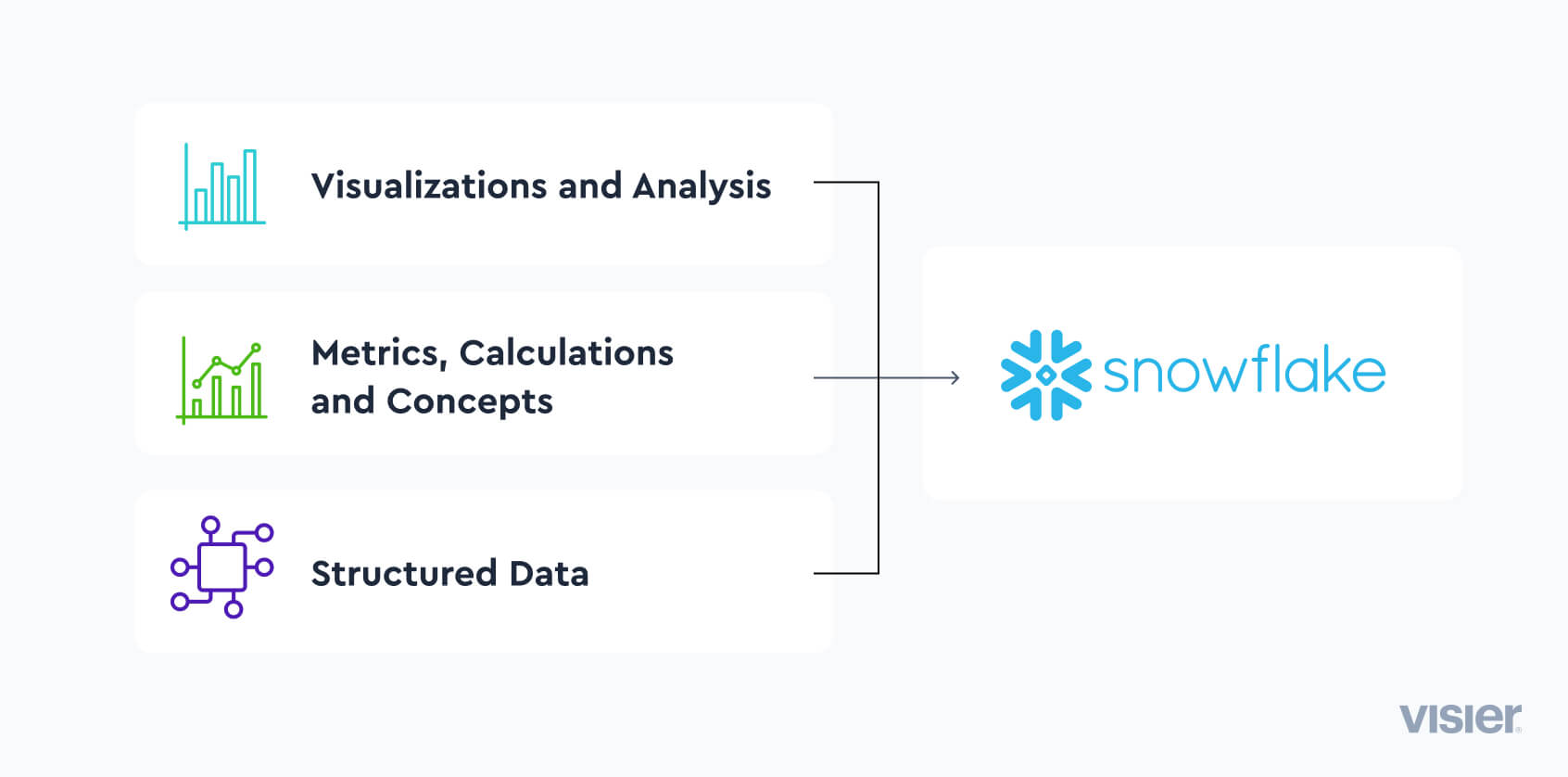
INTEGRATIONS
Better Together: Snowflake + Visier
The analytics tech ecosystem is always growing and evolving. This series guides technical stakeholders in organizations to understand how to uplevel their current ecosystem with Visier.
Get a demo
Table of contents
What is Snowflake and what does it solve?What is Visier and what problems does it solve?How can Snowflake and Visier both be used?How it worksMaximize your tech stackA very popular and growing solution in the market today is Snowflake. Many of our current customers use this solution and we’re often asked how Visier People® fits alongside Snowflake into the broader landscape of an organization’s analytical tech stack. Here, we will unpack some of the details and how to think about combining the power of Snowflake and Visier to create a low-maintenance and high value output from your data. While Visier is largely data source agnostic, Snowflake is a common variable alongside Visier in modern enterprise data ecosystems.
In this post, we're talking about driving the ultimate value: delivering the right insights to the right destination or person at the right time. While there are discrete objectives in the data lifecycle, like consolidating data in a single location or securing access to sensitive data, for our purposes today we will consider how to drive value to that ultimate goal of last mile delivery. Data has maximum impact when it’s distilled for use in the right context.
What is Snowflake and what does it solve?
Snowflake is a powerful tool to aggregate and process data from a variety of sources. The solution, Data Cloud, also does a great job of making sure that whole sets of data can be shared over multiple public clouds like AWS, Google, or Microsoft. Snowflake is often combined with other solutions across the data lifecycle, notably tools for data science and data reporting.
Organizations hands down appreciate the speed of Snowflake in returning queries and also cite the flexible scalability and configurable security. With these qualities, Snowflake has become a central part of an organization’s data ecosystem.
Snowflake’s weakness comes in the last mile delivery of analytical insights, which, to be fair extends beyond what it was built for—to house and organize data. The tool is often integrated with third-party visualization, presentation, or reporting tools to deliver analytical insights to stakeholders at scale.
Some organizations are also reticent about using Snowflake for certain kinds of sensitive data where governance requires more nuance. This can be both for legal purposes like GDPR but also for the inherent nature of the data, like people data. This category of data includes sensitive topics like compensation, diversity, performance, and more. People data represents a unique challenge in configuring a data warehouse environment that can ensure the accurate deletion of data across the ecosystem and data security without overly inhibiting access.
What is Visier and what problems does it solve?
Visier is an analytics infrastructure and data model that specializes in people data trusted for critical decision making in 25,000 organizations around the world. The technologies that underpin Visier have been refined to handle the sensitivity, scale, and complexity of people data. Paired with these technologies is a customizable people data model that has pre-defined metrics to bring rapid time-to-value when you apply your own organizational data.
A key differentiator of Visier is the ability to deliver insights and data in the last mile to a variety of stakeholders, from analysts to executives.
A common misunderstanding is that Visier is a business intelligence tool like PowerBI or Tableau. Although Visier has some of the same functionality, it is closer to a data mart with its own visualization layer for HR and other people data. Contained within our tech stack includes specialized data management, a data model with customizable pre-built metrics, role-based security, visualizations specific to people metrics, descriptive content functionalities, and more designed to the specific nuances of people data.
But a key differentiator and value add from Visier is the ability to provide insights and data in the final mile to a variety of stakeholders. Lay users who just need basic analytical tools to get the right insights can quickly slice and dice data to inform their decisions on demand within Visier’s user interface. Analytical specialists can still do their work in PowerBI or Tableau with pre-calculated metrics or even full datasets as an input for a broader analysis for say finance, sales, or operations. In short, Visier rapidly takes people data from more raw forms to the last mile with precision and efficiency.
How can Snowflake and Visier both be used?
So does this mean throw one or the other away? Of course not. Organizations that have Snowflake and Visier stand to see powerful outcomes through a smart combination of the two solutions. Let’s dig into how.
As described above, Snowflake is masterful at collecting and elevating the quality of datasets but begins to break down with specific applications, more filtered access, or use by less-savvy users. Snowflake is also very powerful in testing a hypothesis and prototyping but struggles in using that metric in an end-user state at scale. Making analytical insights ready for the business on demand requires integration with a reporting, presentation, or dashboarding tool.
Visier’s strength is in the important dimension of people as a subject and its ability to deliver the right insights to the right people at times that are critical either through Visier’s UX or a Visier connector to a third-party BI tool like PowerBI or Tableau. With the right integration between the two, we can deliver rapid time-to-value in a secure delivery of critical workforce metrics to the right stakeholders.
What's the value of using Snowflake and Visier together?
Let’s dive into a scenario to help illustrate an ecosystem just with Snowflake, and one with Snowflake and Visier integrated together.
A commonly used people analytics metric is headcount and movement on a particular date. This metric seems straightforward on the surface but it's actually surprisingly difficult. This is because on any given business day there could be new hire arrivals at 9 a.m. and employee departures at 5 p.m. To simply describe the flow with Snowflake alone you’d need to query the correct parameters for related HRIS tables, ATS or onboarding tables, as well as employee offboarding. Then, you'd have to join these datasets in a PowerBI or Tableau to calculate the new hires, the departures, or the internal movements. Finally, with these calculations combined, you get a truly accurate headcount. It’s doable, but it’s work to get it right when it counts.
By comparison, using Snowflake and Visier, Visier’s Snowflake JDBC connector automatically updates the data to be at the ready. On demand, Visier can provide headcount metrics and distribute them to relevant audiences, including in common analytics tools like PowerBI and Tableau. The following example default diagram from Visier shows the clarity in what can be a surprisingly complicated metric:

The headcount visualization in Visier breaks down important metrics that provide clarity like starts, exits, and moves within an analysis population. Other related metrics are ready out-of-box, like headcount trends.
Thinking outside of just technical factors, there are organizational ones as well. For a business to use metrics effectively there has to be agreement on what metrics mean, how they’re calculated, and how they should be used. Individuals doing the work, such as analysts, and decision-makers alike must support and uphold these agreements. The careful definition of these metrics is key, as the data has implications that impact real people as well as the business.
Out-of-box, Visier brings hundreds of pre-defined metrics and calculations that can be customized to the needs of the business which streamlines the first use, as well as when changes happen in the business. The time spent upfront and over time dramatically decreases with a pre-built people data model that can be flexed to specific needs.
What’s more, analysts and others can use Visier’s business intelligence connectors to pull calculated metrics like headcount as well as tables and other data into their work as they go. If you’d like to grab this calculated metric via API, you can do that as well. We also have a code sample at the ready to help you do just that. This frees up your data teams to focus on higher-order work to drive the right insights across the business.

Beyond headcount, this example applies to thousands of pre-built objects, metrics, and tables. Your team can adjust and tweak the calculation of these metrics within Visier to reflect the policies and definitions of your business.
How it works
For more information about how the configuration occurs, you can read the documentation. But I do think simply overviewing the workflows here is helpful.
Data In
First, create an integration user with the right permissions in Snowflake. Then input the connection credentials in Visier. Visier’s professional services team will help to configure the mapping based on the target tables from the first extract of data. From there, Visier only retrieves data for changed records in the target Snowflake tables.
At that point, as long as your Snowflake tables remain as initially mapped, you’re set to go. You set it and forget it. Your teams can enjoy our role-based permissions to have on-demand access to the right people data, HR metrics, and content to use in their own analysis or decisions. If your tables do change, those changes do need to be updated in the mapping.
What if you have people data that doesn’t reside in Snowflake? Or for compliance purposes, you don’t house people data in Snowflake? Other Visier data intake methods can accommodate the Snowflake connector, as well as other data intake methods like source system connectors, API, SFTP pick up, or flat file upload. The data from other intake methods will seamlessly store and map within Visier to provide a full picture of the workforce.
Data Out
As enterprises evolve their data and analytics strategy, centralizing data is a critical component. Naturally, the question arises of how nicely Visier plays with data centralization strategies. Before we continue you should assess the organizational need and readiness to bring people data back into your data warehouse, since there are ethical, privacy, and security implications the apply to people data.
There are three types of data that could be exported from Visier to Snowflake. First is the Data Versions and Raw Data, which are the datasets brought into Visier. Second is Metrics, Calculations, and Concepts which are the refined data that comes out of Visier’s People Data model. Finally, the third layer includes the actual Visualizations and Analysis.

While there are ways to export data from different layers within Visier, arguably the most valuable data to bring from Visier back to Snowflake is the differentiated data included in Metrics, Calculations, and Concepts. We’ll focus our attention here since it represents the highest value use case in an ecosystem using Snowflake and Visier.
The Metrics, Calculations, and Concepts layer contains calculated metrics like diversity ratios, turnover ratios, performance ratios, recruiting source effectiveness, and more. It could be valuable for an organization to have a series of slices representing a snapshot of key metrics to the business available for redundancy purposes. As you’d expect, Visier can be directly queried for these metrics according to various parameters like a specific period of time, a specific geography, or business unit. So if you’re trying to enable this type of analysis, our APIs and connectors are a more streamlined way to go.
To execute passing this refined data from Visier to Snowflake for single precalculated metrics you can leverage our Data Query API and Data Model API to form a specific query for your export to the data lake. This query functionality also allows parameters to call data for a specific segment of time in the past so you can structure and form what type of data you specifically want to bring into your data warehouse.
What might be more interesting is to catalog the detail for specific inputs to the metric, which can be done through the List API. Let’s use the example of turnover to illustrate how the List API works.
If we wanted to get the turnover detail for the first quarter, we can define the time period and the metric we want details on, specifically turnover. The API would return tabular lists containing the specific details of who exited through resignation, retirement or involuntarily. Future analysis could recompose the calculation of the metric within the parameters using the data from List API. But again, all of this can be done directly through Visier and the true value add is comfort in data redundancy.
Maximize your tech stack
Each tech configuration is different but there is flexibility with Visier for those who architect, maintain, and use Snowflake as a data warehouse in the workflows of data-in and data-out. Regardless of where your people data is kept, whether in source systems, in Snowflake, spreadsheets on desktops, or a combination of sources, Visier has the flexibility to intake that data, light up critical workforce metrics, power analytics teams, and deliver insights to their point of value quickly.
If you already have Snowflake in your tech stack, you already have a maturity in your data strategy that can go further faster with Visier. But ultimately, Snowflake isn’t required to get a fully functional deployment of Visier. In the end, your business has what it critically needs—the right data in the right hands at the right time to drive elevated results that can be adapted quickly as the business evolves.
Want to learn more? Get a demo and let’s talk about how to maximize your tech stack with Visier People®.

